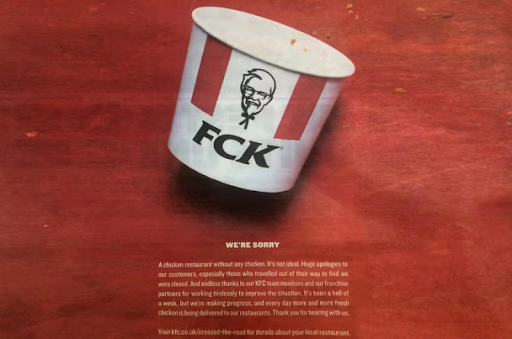“Finally,” you say.
“The content calendar is finished and the posts are coming out as usual, it’s time to take the foot off the gas.”
Suddenly: *plimm* *plimm* *plimm* *plimm*
They’re notifications of negative comments on your latest post. Your followers are unhappy with your created content and want justifications.
Suddenly, you have a crisis on your social media, years of brand reputation are about to go down the drain, and you don’t even know where to start.
In this article you will learn:
- What is a social media crisis
- How to manage a social media crisis
- How to anticipate a crisis
- Examples of how global brands have managed crises.
At the end of the article, you will find examples of how Burger King, Tide, and KFC have dealt with crises on their social media, applying many of the same factors discussed here.
What is a social media crisis?
A social media crisis is an online phenomenon that puts your brand’s reputation or operation at risk and involves a lot of negative activity and conversation around your social media profiles.
A crisis can have varying degrees of severity, from just a few negative comments to attempts to boycott the brand.
Usually, social media crises are caused by an offensive, dangerous or misleading post that leads to public discontent.
However, a social media crisis can also originate from factors outside of online, such as misbehavior by a company employee.
But regardless of whether it originates online or offline, it’s certain that consumers will talk about it online, and cause the social media manager a nightmare.
So let’s find out how you can manage a social media crisis.
How to manage a crisis on social media
1. Identify the source of the problem
The first step to managing a social media crisis is quite obvious, but it is probably one of the most important ones.
Often the social media manager finds himself receiving negative comments, with little or no context, without realizing what was the event that triggered everything.
When this is the case, there are a few ways to figure out what the source of the crisis is:
Internal communication
If you are part of a large team, gather all the members of the social media team and start asking questions about what has been done and by whom, to understand if something is off plan.
If you identify that the problem did not originate from the communication team, then talk to the heads of each department to see if they committed any irregularities.
Look for patterns and keywords in the comments
Do all comments have a specific keyword? Then that’s likely the problem.
This discovery method is where you can look for patterns in the comments.
This task can be done manually, or use a social listening tool (which we will see below), to identify the source of the problem as quickly as possible.
Check the profiles of the influencers you partner with
It is very common for your brand to be criticized if one of the influencers you partner with is involved in some kind of problem.
Here it is important to contact and/or observe the profiles of all your brand’s partner influencers and analyze if any of them made any problematic posts or comments.
After assessing the situation, you will have to decide together with the influencer and your brand, what is the best step to take to minimize the damage to your brand’s reputation.
2 – Define a response plan
Now that you’ve identified from where (or whom) the problem came, it’s time to communicate internally again, to decide on a uniform response across all channels.
The last thing you want in the middle of a crisis is to say different things on different platforms.
Think about which social media and content formats make sense to use to respond to the issue.
Is going public on Instagram stories more effective than a written statement? Or is a personal approach, such as sending a direct message to each customer, more appropriate?
Finally, it’s important to be flexible and put your pride aside (seriously).
As you’ll see in the Burger King example at the end of the article, it’s better to take a step back and apologize than to insist on your idea, even if you think it’s a good one.
3. Create a response team
Once you have the response plan, it’s time to set up a team to solve/minimize the crisis.
It is a good practice to involve the support team (if there is one) in this plan, as many of the customers may also turn to the website chat for explanations.
Everyone should follow one tone of voice and one message, communicating it clearly and according to what was defined in the internal meeting.
4. The various phases of response to a crisis
There are crises that require several phases of response.
If the social media and support team cannot handle the situation, it will be necessary to gradually escalate up the hierarchy of positions within the company, so that a more elaborate response can be made.
Sometimes it is also necessary for content to be created specifically to address the crisis at hand. This implies that you need to put your editorial calendar on pause in order to focus fully on resolving the crisis.
If responding to comments is not enough to manage your crisis, then you can follow for example the following order of crisis management:
1- Social media team and support team respond to comments
2 – Social media team and support team respond to comments + guidance from the department manager
3 – Social media team + department manager pause the editorial calendar and create content to deal with the situation
4 – Social media team + department manager + senior management create an overall communication plan
5 – Social media team + department manager create various content to resolve the crisis, and if necessary, the senior management “takes the lead” in resolving the crisis.
How to anticipate a crisis
There are a number of practices you can implement to avoid a crisis on your social media such as:
Train your team
If more than one person manages your company’s social media profiles, then everyone should follow a protocol on how to respond to comments, what tone of voice to use, and what to do in specific situations.
If you are the sole social media manager, this protocol should still be defined, and you should be guided by it throughout the crisis.
Have an internal approval flow
To avoid mistakes that could trigger a crisis, set up an internal content approval system so that anything that goes out publicly has a second pair of eyes reviewing it.
The key is not to make the process too complicated, as this can slow down content creation and editing.
Swonkie allows you to send a link to approve your content to any member of staff, without having to log in to the platform.
You can test this feature here.
Monitor your social media
To anticipate a crisis, it’s essential to stay on top of what’s being said about your brand on all social media.
But to control everything that is said everywhere, unless you want to be awake 24/7 looking at the comments of your publications, you will need to use software that allows you to monitor.
Swonkie allows you to access a dashboard with all the mentions that are made about your brand, as you can see below:

This way you can monitor in real time whenever your brand is mentioned.
You may also want to monitor other keywords related to your industry or brand, so you have a more extensive coverage of what is being said.
Examples of how global brands have managed crises on social media
Burger King
In an effort to draw attention to its female chefs, Burger King made this tweet (or X’s? with the new Twitter rebranding *nervous laugh*)

For obvious reasons, this Tweet generated quite a stir in the community, even though the 2nd tweet was an explanation of the idea:

To solve this situation, Burger King, in the first approach, tried to solve the crisis through dialog.
However, this was not enough to resolve it, and after moving on to the second step of crisis management, they ended up removing the Tweet.

Tide
The Tide Pod Challenge gained notoriety as an online trend.
It consisted of eating Tide detergent in pod form, which led to several teenagers ending up in the hospital.
To address this crisis, Tide decided to use American soccer player Rob Gronkowski as a spokesperson and launched a digital campaign to prevent this dangerous behavior.

You can see the campaign here
KFC
In February 2018, Kentucky Fried Chicken restaurants in Britain were forced to close after running out of chicken.
To deal with this situation, the company created a dedicated website detailing the crisis, and the page began with the following statement:
“Chicken has crossed the road, but not to our restaurants”
But they didn’t stop there. They also created an ad that caught everyone’s attention, changing the order of their name from KFC to FCK.
After that, the company apologized as you can see in the image below:

